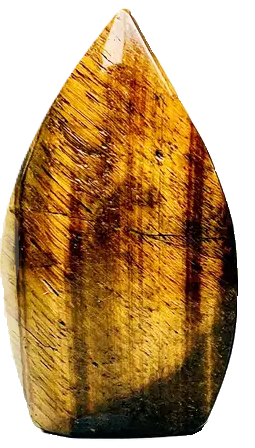
Yellow Tiger’s Eye, a captivating gemstone with its golden hues and shimmering chatoyancy, has fascinated humanity for centuries. This article delves into its origins, composition, geographical distribution, historical significance, mystical properties, and more.
Origins of Its Name and Alternate Names
The name “Tiger’s Eye” derives from the stone’s striking resemblance to the eye of a tiger, showcasing golden-brown bands and a silky lustre. Additionally, it is often referred to as “Golden Tiger’s Eye” and “Yellow Tiger’s Eye,” terms that emphasise its radiant colour. In historical contexts, the stone gained the name “pseudocrocidolite,” reflecting its unique formation process. Through these evolving names, Tiger’s Eye has continuously highlighted its captivating appearance and distinctive characteristics.
Composition, Physical Characteristics, and Varieties
Yellow Tiger’s Eye is a variety of quartz composed primarily of silicon dioxide (SiO₂). Its unique chatoyancy, or “cat’s eye effect,” is caused by the reflection of light on parallel fibrous inclusions, often of crocidolite that has been replaced by quartz. The stone typically exhibits golden-yellow to golden-brown hues, with a silky or glassy lustre. Varieties include:
- Golden Tiger’s Eye: The most common form, with warm golden tones.
- Blue Tiger’s Eye (Hawk’s Eye): A rare variety with bluish hues.
- Red Tiger’s Eye (Ox’s Eye): A reddish-brown variant created through heat treatment.
Geographical Locations
Yellow Tiger’s Eye is predominantly found in South Africa, especially in the Northern Cape Province, Australia, particularly in Western Australia, the United States, in states like California and Arizona, and in India and Brazil, known for their rich deposits of this gemstone.
Archaeological and Historical Significance
Tiger’s Eye has been cherished since ancient times. In Ancient Egypt, it was used in jewellery and statues, symbolising divine vision and protection. Roman soldiers carried it into battle, believing it would deflect weapons and instil courage. Significant finds in South Africa during the 19th century brought it to global prominence, making it a popular choice for jewellery and ornamental objects.
Interesting Facts
Heat treatment can enhance its colour, transforming golden Tiger’s Eye into red varieties. With a Mohs hardness of 7, it is suitable for everyday wear. Its chatoyancy creates a moving light effect, adding to its allure.
Folklore, Superstition, Legends, and Tales
Yellow Tiger’s Eye has long been associated with protection and courage. Ancient cultures believed it warded off the “evil eye” and brought good fortune. In Chinese mythology, the tiger symbolises strength and bravery, aligning with the stone’s perceived properties. Legends also suggest it was used as a talisman to enhance focus and clarity.
Mystical Healing Properties
Yellow Tiger’s Eye is celebrated for its grounding and protective energy. It is believed to enhance confidence and courage, promote mental clarity and focus, balance emotional energies, and attract prosperity and good fortune.
Links with Astrology and the Zodiac
Yellow Tiger’s Eye is particularly beneficial for zodiac signs like Leo, enhancing leadership and courage; Capricorn, providing grounding and stability; and Gemini, promoting clarity and balance.
The Chakra System
This gemstone is closely linked to the Solar Plexus Chakra (Manipura), which governs personal power, confidence, and decision-making. It is also associated with the Root Chakra (Muladhara), providing grounding and stability.
Use as a Birthstone and for a Wedding Anniversary
While not a traditional birthstone, Yellow Tiger’s Eye is often used as an alternative for those seeking its protective and empowering qualities. It is also the gemstone for the 9th wedding anniversary, symbolising strength and resilience in a relationship.
Yellow Tiger’s Eye continues to captivate with its beauty, history, and mystical properties. Whether worn as jewellery or used in spiritual practices, it remains a timeless symbol of courage, clarity, and protection.
